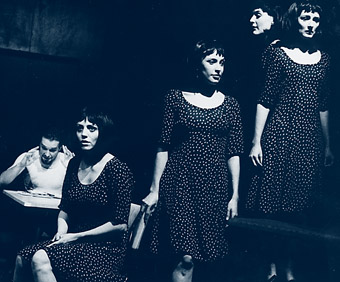More than one Dolores
Maryann Robinson: Richard Murphet, Dolores in the Department Store

Angus Grant, Alice McConnell, Catherine Moore, Jodie Harris + Rita Kalnejais, Dolores in the Department Store
photo Heidrun Löhr
Angus Grant, Alice McConnell, Catherine Moore, Jodie Harris + Rita Kalnejais, Dolores in the Department Store
Many things happen at once in Dolores in the Department Store, which is difficult to get clear in the mind because it is not about clarity of mind. Richard Murphet’s text is poetry, rap, witness statements (“I, Dolores…”), dream images, psychoanalysis and chat, shopping lists and bills. The setting is contemporary culture–half stage, half catwalk–with a doctor on one side and an actress on the other, with the store above and the domestic scene below. The swamp, the deep pit that we all walk past, is sensed somewhere under the stage.
Story, soundscape and movement go in under the skin in pieces, not caught in the sieve of reason. Music, ads and original songs full of irony flow thick and fast with feeling. Cultural images and theatrical portrayals of the crazy woman (from “Out, damned spot” onwards) flash past.
There is more than one person being one person who is more than one person: Dolores is 4 actors who are all Dolores, who has multiple personalities. Dressed alike, wigged alike, they are the same but different as sisters, clashing, speaking in each other’s minds. This small flock of Dolores illustrates tension and flow within one person. She moves up the steps towards the doctor’s door, split within, changing her minds. There is the violence of an iron in her hand as one tries to throw it and one pulls back. What is she trying to smooth out, burn away? Dolores 3 stares deep into the pit, seems drawn in. The story is that something came out–a swamp man, her father–and pushed himself into her 11 year old self. Swamp man dead inside her. She split.
Consumption returns in multiple forms, an appetite for things that at the same time devour us. The store has everything: bright lights, culture, all the endless lists of stuff bought and brought home to fill an empty place. The store sells people as they should be, smiling and whole, desirable people who manage, dressed in Chanel, with little assistants at their feet. Dolores 2 wants red stilettos and a vamp dress. An appetite to devour or damage another is sexualised. Her husband desires something in Dolores, but his appetite consumes him as well. He is filled, animated with a surging violence that aims at Dolores 1 but seems to hurt him, to empty him. He has no self-control, perhaps no self, perhaps only control of her. Maybe the dress gives Dolores power over somebody who has power over her, but only if she can split. Being 2 allows her to stand behind him while he empties himself into 1. A puppet-child, cut from the same cloth as her mother, floats around these dangerous adults. There is no help
for her.
Images of the sexual woman, red dress and stilettos, or smoking in her satin wrap, in a boudoir, blend sickeningly with the ‘incest survivor’ as vamp, drawing violence to her. Very film noir, very spider woman, dressing the commerce of her sexuality as his trap.
The other consumption is one we participate in. We watch actors empty themselves to be others for us. A young soapie actress tries to reach an audition to play the part of this woman with many parts. Making her way through the department store–or her career or drama school–she is lost, clutching the wig and dress, wanting someone to come and take her home. The appetite of audience and industry devours young performers in their own success, to be desired, losing the self to other temporary inhabitants pushed into them. At the end, the Dolores approach the audience, not acting any more. But we can’t see them because this is theatre and they are performers we only watch being others.
Richard Murphet, Dolores in the Department Store, directors Leisa Shelton & Richard Murphet, Company 2001, performers Alice McConnell, Catherine Moore, Rita Kalnejais, Jodie Harris, Angus Grant, Luisa Hastings Edge, Simon Aylott, Amanda Falson, Peter Cook, Patrick Brammall, Aaron Halstead & Luke Mullins, VCA School of Drama, Grant Street Theatre, Melbourne, April 6-11
RealTime issue #43 June-July 2001 pg. web






